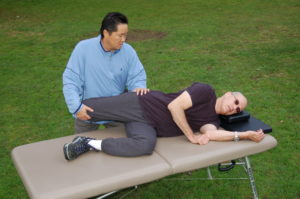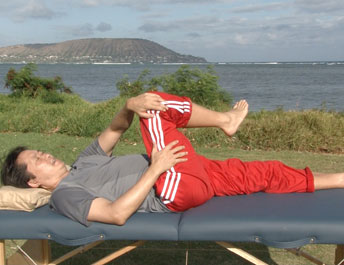 A typical session is performed on a massage table. The client wears athletic clothing and sneakers.
A typical session is performed on a massage table. The client wears athletic clothing and sneakers.
A seat belt is used to tie down the client to the table. This helps to isolate the muscles to be stretched.
A rope is used and held by the client to facilitate movement.
Active Isolated Stretching is more like a workout than a massage. The client must try to stretch, the therapist helps the client go further than self-stretching. The therapist is trained to know the optimal amount a target muscle can lengthen.
The aim of Active Isolated Stretching is to unwind the muscles that are causing the pain problem.
Muscles work in groups. Meaning that a series of muscles affect a problem area. It is more productive to unwind all the key muscles in one session vs. unwind a few muscles one session then wait to the next session to unwind other problem muscles. This process takes more than one hour. Productive sessions can last two to four hours. It is not uncommon for a session to last even longer.
Most clients will feel an immediate change to their pain problems after one or two sessions. Active Isolated Stretching allows the body to repair/heal itself. In many cases, a client will continue to improve two or three days after the session. Inflammation continues to reduce 48 hours after the session. Nerve signals can be reset as muscle inflammation subsides. The goal is to achieve appropriate tensional balance in the muscle structure: tensegrity. What does it feel like? It feels like your body is floating in the structure.






Hi! I am a writer, interior designer and mother of four living in New York City. I am also an avid exerciser and I am in exceedingly good shape – except for the persistent, disabling pain in my lower right side (back; hip, piriformis; psoas; bulging disk at L5) which I now believe is caused by a tight psoas muscle. I found your website incredibly informative and useful as I’ve run the gamut from cortisone injections to MRI’s to Alexander Technique, etc, etc. I’ve seen so many “top” people here to no avail and was last week encouraged to consider a discectomy, which thankfully my doctor said is premature. Thanks so much!
i wolud like how to perform these stretches. how to get permitted to do so.
Anthony Ohm wrote:
To Nola W.,
I’m in Honolulu, Hawaii. I think I’m your closest AIS practitioner.
I’m going off island in mid-July. Back in August.
Then in Los Angeles, California in September.